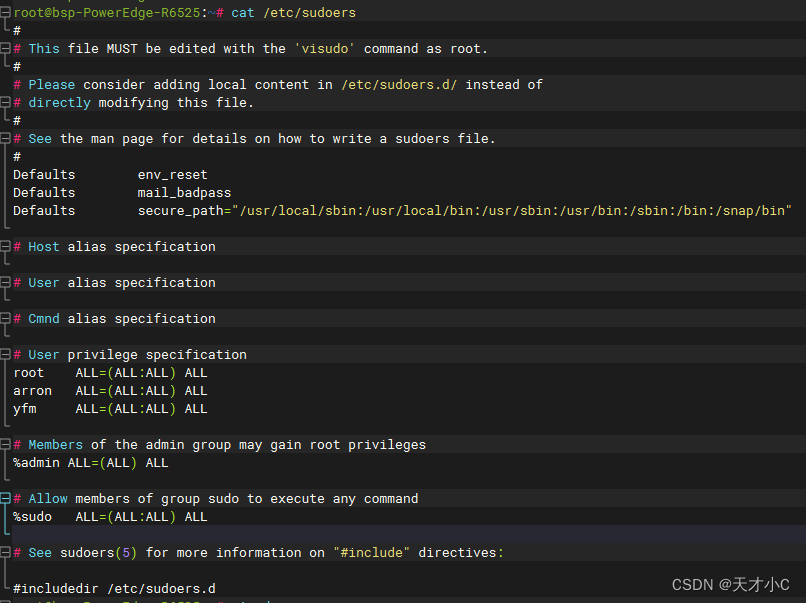Linux sudo与/etc/sudoers
sudo介绍
- sudo命令可以让普通用户在执行需要超级用户权限的命令时,临时提升为超级用户。例如,普通用户可以使用sudo执行系统管理任务,如安装软件、修改系统配置等。
- 访问控制:sudo命令通过sudoers文件中的配置,可以对用户和用户组进行细粒度的访问控制。管理员可以指定哪些用户可以使用sudo以及可以执行哪些命令。
- 审计和日志记录:sudo命令可以记录用户执行的每个sudo命令,包括命令的时间、执行者和执行的命令本身。这对于安全审计和故障排除非常有用。
- 环境变量控制:sudo命令可以通过Defaults行中的配置,控制sudo命令执行时的环境变量。这有助于确保以root权限执行命令时,环境变量不会被滥用或篡改。
- 密码验证:sudo命令通常需要用户输入自己的密码来验证身份。这增加了安全性,确保只有授权的用户可以执行特权命令。
sudo apt install net-tools
sudo dmesg
sudo lshw/etc/sudoers文件介绍
root@bsp-PowerEdge-R6525:~# cat /etc/sudoers
#
# This file MUST be edited with the 'visudo' command as root.
#
# Please consider adding local content in /etc/sudoers.d/ instead of
# directly modifying this file.
#
# See the man page for details on how to write a sudoers file.
#
Defaults env_reset
Defaults mail_badpass
Defaults secure_path="/usr/local/sbin:/usr/local/bin:/usr/sbin:/usr/bin:/sbin:/bin:/snap/bin"
# Host alias specification
# User alias specification
# Cmnd alias specification
# User privilege specification
root ALL=(ALL:ALL) ALL
# Members of the admin group may gain root privileges
%admin ALL=(ALL) ALL
# Allow members of group sudo to execute any command
%sudo ALL=(ALL:ALL) ALL
# See sudoers(5) for more information on "#include" directives:
#includedir /etc/sudoers.d
- Defaults env_reset: 这个行指定了默认的环境变量重置规则,当用户使用sudo命令时,环境变量将被重置为默认值。
- Defaults mail_badpass: 这个行指定了当用户输入错误密码时,系统会发送邮件通知。
- Defaults secure_path="/usr/local/sbin:/usr/local/bin:/usr/sbin:/usr/bin:/sbin:/bin:/snap/bin": 这个行指定了sudo命令的安全路径,即sudo命令可以在这些路径下执行。
- root ALL=(ALL:ALL) ALL: 这个行指定了用户root可以在任何主机上以任何用户身份执行任何命令。
- %admin ALL=(ALL) ALL: 这个行指定了admin组的成员可以在任何主机上以任何用户身份执行任何命令。
- %sudo ALL=(ALL:ALL) ALL: 这个行指定了sudo组的成员可以在任何主机上以任何用户身份执行任何命令。
- #includedir /etc/sudoers.d: 这个行是一个注释,指示可以使用#include指令来包含其他sudoers文件的路径。在这个例子中,它指定了/etc/sudoers.d目录下的文件将被包含进来。
visudo修改/etc/sudoers文件
如何给用户添加sudo权限
修改/etc/sudoers
在下面添加
# User privilege specification
root ALL=(ALL:ALL) ALL
+++
arron ALL=(ALL:ALL) ALL
arron ALL=(ALL:ALL) ALL: 这个行指定了用户arron可以在任何主机上以任何用户身份执行任何命令。添加输出密码提示
修改/etc/sudoers
+++
Defaults badpass_message="Password is wrong, please try again"添加重试次数
修改/etc/sudoers
+++
Defaults passwd_tries=5 sudo生效持续时间(默认5分钟)
timestamp_timeout Number of minutes that can elapse before sudo will ask for a passwd again. The timeout may include a fractional component if minute granularity is insufficient, for example 2.5. The default is 15. Set this to 0 to always prompt for a password. If set to a value less than 0 the user's time stamp will not expire until the system is rebooted. This can be used to allow users to create or delete their own time stamps via “sudo -v” and “sudo -k” respectively.
修改/etc/sudoers
+++
Defaults timestamp_timeout =10等待用户输入时间
passwd_timeout Number of minutes before the sudo password prompt times out, or 0 for no timeout. The timeout may include a fractional component if minute granularity is insufficient, for example 2.5. The default is 0.
修改/etc/sudoers
+++
Defaults passwd_timeout=2sudo log设置
Logging
sudoers can log both successful and unsuccessful attempts (as well as errors) to syslog(3), a log file, or both. By
default, sudoers will log via syslog(3) but this is changeable via the syslog and logfile Defaults settings. See LOG
FORMAT for a description of the log file format.
Defaults@SERVERS log_year, logfile=/var/log/sudo.log
修改/etc/rsyslog.conf文件
+++
local2.debug /var/log/sudo.log
修改/etc/sudoers
+++
Defaults logfile=/var/log/sudo.log
Defaults loglinelen=0
Defaults !syslog
创建日志文件
touch /var/log/sudo.log
systemctl restart rsyslog
su介绍
su命令是在Unix和类Unix系统上使用的命令,用于切换用户身份。下面是su命令的一些常见用法和功能:
1. 切换用户:su命令可以让当前用户切换到另一个用户的身份,例如从普通用户切换到root用户。默认情况下,su命令会切换到root用户,但也可以指定其他用户。
2. 执行命令:su命令可以在切换用户后,直接执行命令。例如,可以使用su命令切换到root用户,然后执行需要root权限的命令。
3. 环境变量:su命令可以在切换用户时,保留原用户的环境变量。这对于需要在新用户身份下执行命令,但需要使用原用户的环境变量的情况非常有用。
4. 密码验证:su命令通常需要用户输入目标用户的密码来验证身份。这增加了安全性,确保只有授权的用户可以切换到目标用户的身份。
su命令用法:
1. 切换到root用户:
```
su
```
执行上述命令后,系统会提示输入root用户的密码。输入密码后,即可切换到root用户身份。
2. 切换到其他用户:
```
su username
```
执行上述命令后,系统会提示输入目标用户的密码。输入密码后,即可切换到目标用户身份。
3. 切换并执行命令:
```
su -c "command"
```
执行上述命令后,系统会提示输入root用户的密码。输入密码后,系统会以root用户身份执行指定的命令。
4. 切换并保留原用户的环境变量:
```
su -m username
```
执行上述命令后,系统会提示输入目标用户的密码。输入密码后,系统会切换到目标用户身份,并保留原用户的环境变量。
5. 切换并指定shell:
```
su -s /bin/bash username
```
执行上述命令后,系统会提示输入目标用户的密码。输入密码后,系统会切换到目标用户身份,并使用/bin/bash作为shell。
root@admin:/home# adduser arron-build
Adding user `arron-build' ...
Adding new group `arron-build' (1010) ...
Adding new user `arron-build' (1010) with group `arron-build' ...
Creating home directory `/home/arron-build' ...
Copying files from `/etc/skel' ...
New password:
Retype new password:
passwd: password updated successfully
Changing the user information for arron-build
Enter the new value, or press ENTER for the default
Full Name []:
Room Number []:
Work Phone []:
Home Phone []:
Other []:
Is the information correct? [Y/n]
root@admin:/home#
root@admin:/home#
root@admin:/home#
root@admin:/home#
root@admin:/home# visudo
root@admin:/home#
root@admin:/home# su arron-build
arron-build@admin:/home$su和sudo区别
1. su命令需要目标用户的密码,而sudo命令需要当前用户的密码。使用su命令切换到目标用户身份时,需要输入目标用户的密码。而使用sudo命令执行需要root权限的命令时,需要输入当前用户的密码。
2. su命令切换到目标用户身份后,会保留原用户的环境变量。而sudo命令执行命令时,默认情况下会清除原用户的环境变量,只保留少量的安全环境变量。
3. su命令切换到目标用户身份后,会一直保持该身份,直到使用exit命令退出。而sudo命令执行完命令后,会自动返回原用户身份。
4. su命令需要使用root用户或具有sudo权限的用户才能使用。而sudo命令只需要当前用户具有sudo权限即可使用。
总的来说,sudo命令更加灵活和安全,因为它只需要输入当前用户的密码,而且执行命令时会清除大部分环境变量,从而减少了潜在的安全风险。但是,在需要长时间使用root权限的情况下,su命令更加方便,因为它可以一直保持目标用户身份,而不需要反复输入密码。
本文来自互联网用户投稿,该文观点仅代表作者本人,不代表本站立场。本站仅提供信息存储空间服务,不拥有所有权,不承担相关法律责任。 如若内容造成侵权/违法违规/事实不符,请联系我的编程经验分享网邮箱:chenni525@qq.com进行投诉反馈,一经查实,立即删除!
- Python教程
- 深入理解 MySQL 中的 HAVING 关键字和聚合函数
- Qt之QChar编码(1)
- MyBatis入门基础篇
- 用Python脚本实现FFmpeg批量转换
- 【网络安全】上网行为代理服务器启用Alerts
- 【实用】Linux网络配置:初学者指南
- TypeScript【泛型1、泛型2、声明合并、命名空间 、模块1、模块2、声明文件简介】(五)-全面详解(学习总结---从入门到深化)
- PDF模板填充,基于IText5
- 网络游戏APP备案|游戏
- docker快速部署redis
- dayjs的使用
- Linux驱动开发笔记(六):用户层与内核层进行数据传递的原理和Demo
- 「 网络安全术语解读 」通用攻击模式检举和分类CAPEC详解
- 【VisualStudio 2022】常见配置合集(持续更新)